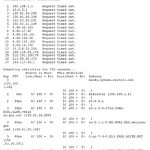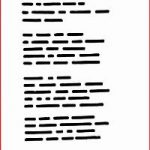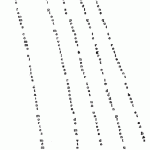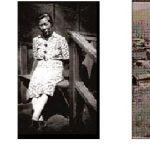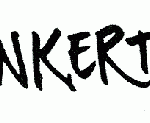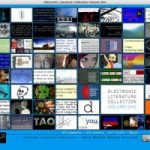2009
Sandy Baldwin investigates the manner in which a computer "ping trace" can be classified as a form of digital poetics, and discusses the underlying symbolic practices of both poesis and poetics that encompass coding and computation.
Sandy Baldwin explores the distinctions between non-digital poetry, digital poetry, and e-literature in general, and considers whether or not such distinctions are ultimately untenable.
"Man Ray, Mina Loy, Gertrude Stein, themes of disorientation, displacement, diaspora, defamiliarized language" and that's just the d's. With such "little clues, like stitches coding a special language," Maria Damen weaves an essay-narrative based on her Summer 2007 residency in Riga, Latvia.
2008
"Why shouldn't Wordsworth be read through Whitehead? Why shouldn't the canon of Romantic poetry be read alongside the inscription technologies of cartography or tour guides?" Eugene Thacker's challenge to the recent compartmentalization of academic literary studies is inspired by a reading of Ron Broglio's book, Technologies of the Picturesque. For Thacker, as for Broglio, literary Romanticism and phenomenological reflection are not the only unifying forces against the dissolution of the t...
Michael McDonough reviews Brian Kim Stefans' book of poetry Before Starting Over, asserting that Stefans is concerned with the redefinition of critical discourse in the face of the loss of the singularity of the work of art. Stefans is not out to substitute an ideology of surface and take our deep meanings away. He mines contemporary poetics with an encyclopedic attention while resisting dogmatic assertions.
Tim Peterson brilliantly lays out for us how Charles Bernstein's Girly Man represents the mobilization of queer rhetoric, iconoclastic values, and an implied notion of the family in the figure of the Girly Man.
2007
Lori Emerson introduces a gathering of nineteen electro-poetic essays. This gathering brings together both critics and creators of electronic poetry; as is usually the case in ebr, the 'electronic' does not exclude, but helps us to reconfigure and revalue poetic works in print as well as define what works in digital environments.
Charles Bernstein. Keyword: speed. Speed as a morally coded concept. Speed as success. An ethics of speed. Speed-reading. Virtual reading. Cultural speed-up. Speed kills.
Reading Stephanie Strickland's V: Losing L'una/WaveSon.nets/Vniverse, Jaishree Odin explores the implications of the paradigm shift from modernity to postmodernity for our understanding of reading, writing and living.
Marjorie Perloff reflects on the legacy of misreadings of Robert Creeley's work and argues that his complex poetics should be read transnationally.
In his review of two of Robert Creeley's last published books, Douglas Manson urges us to read these late poems as sending ideas outward, toward an "outside," so that we begin gathering in tomes, searching for quotes.
Douglas Barbour reads Marjorie Perloff's Differentials: Poetry, Poetics, Pedagogy as a notable addition to her oeuvre, another grab-bag of pertinent, impertinent, and always provocative readings of both a wide range of works and some of the social/cultural contexts in which we read them.
Søren Pold explores the ways in which Christophe Bruno's Iterature expands the notion of literary form and shows what happens when words are no longer only part of a language.
Adalaide Morris considers 'tutor texts' in the Electronic Literature Collection and, in doing so, articulates a poetics for the emerging field of e-lit. Instead of fulfilling Ted Nelson's dream of 'computer lib,' the most compelling entries in the Collection emphasize the continuing necessity of writing under constraint. When the revolution turns out to be, not a liberation from a culture of control but its transformation, practices long familiar to experimental poets in print become generali...
John Zuern considers the significance of the first volume of ELO's Electronic Literature Collection for the future of electronic arts.
Chris Funkhouser reads the Electronic Literature Collection Vol. 1 as a crucial document, an effective reflection of literary expression and areas of textual exploration in digital form.
Sandy Baldwin identifies Eduardo Kac as a conceptual artist, a forerunner of electronic poetry, and a critical writer whose essays perform their own content: "writing on new media art as new media art."
Eugene Thacker resituates the work of Eduardo Kac, not as art applied to the life sciences, but as a form of bio-poetics, consistent with the electro-poetics that has been a longtime focus of critical writing in ebr. Rather than reduce the work to its material (in life-forms, or in text, or in code), Thacker identifies ways that language, form, and life intersect in works of bio-art.
For Jay Murphy, Clayton Eshleman in his JUNIPER FUSE makes a resounding case for lived experience, for the tortuous growth, however partial or fragmented, as rooted in self-suffering as modes of vision and dream.
For Angela Szczepaniak, Canadian poet Stephen Cain visually distorts language by blurring the borders of poetic language and national identity, which are often assumed to be much more clear and distinct than they actually are.
